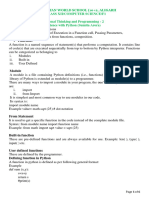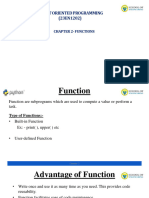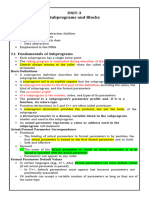Unit-1
Working with Functions
Functions
• A Function is a sub program that acts on data
and often returns some value.
• A Function is a piece of code which performs
a task.
Understanding Functions
• def means a function definition is starting.
• Identifier following def is the function name.
• Variables inside parentheses are called as
arguments(parameters).
• Colon at end represents needed indentation.
• A function may/may not have a return
statement.
Sample Function
def aoc(r):
a=3.14*r*r
return a
def coc(rad):
circum=2 * 3.14 * rad
return circum
k=(int)(input("Enter Radius : "))
y=aoc(k)
print("Area of Circle with radius ",k," is ",y)
z=coc(k)
print("Circumference of circle with radius ",k," is ",z)
def aoc(r):
a=3.14*r*r
return a
k=int(input("Enter Radius : "))
y=aoc(k)
Example Python Function
Calling/Invoking Function
<function-name>(<values/variable passed)
Ex:-
aoc(4)
x=8
aoc(x)
k=(int)(input("Enter Radius : "))
aoc(k)
print(aoc(3))
Z=2 * aoc(6)
Home work
• Write a function to find a number is even or
odd.
• Write a function to take a number as input
and display a pattern
1
12
123
1234
12345
Python Function Types
1. Built in : pre defined functions
created by python and are always
available. (print(),input(),......)
2. Functions defined in Modules:
(math,random,pandas,....)
pow(),sqrt(),sin(),ciel(),randint(),se
ries(),........
1. Import module
2. Use them
3. User defined functions: functions
defined by us to meet new
requirements.
Defining Python Function
def <fun-name>(parameters):
<statements>
<statements>
def sum(x,y): def greet():
z=x+y print(“good morning”)
return z
Function Header: begins with def keyword and
ends with :
Parameters: variables listed in parentheses ()
Function body: block of statements indented,
may/may not have a return statement.
Even a function not returning any value can
have a return statement.
Structure of Python Program
def function1()
:
def function2()
:
#top level statements
Statement1
Statement2
Note: By default python names the top level segment as
__main__ and stores in a built in variable __name__
→Python always start execution from __main__ segment.
Flow of Execution
• Flow of execution refers to the order in which
statements are executed during a program
run.
• Function call will send the control flow to the
function definition.
• Last statement in the function definition will
send the control back to section from where
the function was called.
Flow of execution
Note:
• Program execution begins with first
statement of __main__ segment.
• def statements are also read but
ignored until called.
Types of Parameters
1. Positional/Required arguments
The function call statement must match the
number and order of arguments as defined in
function definition, these are called as
positional arguments.
Function Definition
def sim_int(p,t,r):
-----
-----
Function call
sim_int(a,b,c) sim_int(10000,b,c)
sim_int(10000,2,c)
2. Default arguments
A Parameter having default value in function
header is known as default arguments.
A parameter having a default value in function
header becomes optional(may or may not) in
function call.
Positional parameters should be before default
parameters.
Function Definition
def sim_int(p,t,r=2):
-----
-----
Function call
sim_int(10000,3)
sim_int(10000,3,4)
3. Keyword arguments
Keyword arguments are the named arguments
with assigned values being passed in the
function call statement.
Function Definition
def sim_int(p,t,r):
-----
-----
Function call
sim_int(p=30000,t=3,r=2)
sim_int(t=3,r=3,p=10000)
sim_int(r=2,t=2,p=15000)
Rules for combining arguments
→ An argument list must first contain
positional(required) params
→having positional args after keyword args will
result into error.
→having positional args after default args will
result into error.
→all required parameters are compulsory.
Excercise
def sim_int(prin, cc, t=3,r=2):
return (prin*t*r)/100
Function call Valid/Invalid
sim_int(prin=10000,cc=3) Valid
sim_int(r=3,prin=50000,cc=3) Valid
sim_int(15000,4,r=4) Valid
sim_int(r=5,20000,3) Invalid (pos. Args are after
keyword args)
sim_int(15000,prin=10000,cc=3) Invalid (Multiple values for prin)
sim_int(p=10000,cc=3) Invalid (p is not defined)
sim_int(10000,r=3,t=4) Invalid (No value for CC)
Returning Values
1. Non-void functions
→ Function returning some value
return value/variables/expressions
Ex: def sum(a,b):
→ return 10
→ return x
→ return x+y
→ return (a+b+c)//3
Function call
→ z=sum(10,20) → a=(b+c+d)/sum(2,20)
→ print(sum(240,320))
if sum(10,25) > 30:
print(“good”)
else:
print(“bad”)
Returning Values
2. void functions
→Function does not return any
value.(Even It may have a return
statement)
→Ex:- return
→ Function call
sum(10,20)
Parameters
3. With Parameters
if a function receives args then the
function can be treated a function with
parameters.
Ex: def sum(a,b):
-----
def greet(name):
------
Parameters
4. With out Parameters
if a function does not receives any args
then the function can be treated a
function with out parameters.
Ex: def sum():
a=10
b=20
def greet():
name=input(“enter a name”)
Returning value(s)
1. The return statement inside a
function body takes a below form:
return val1/exp1,val2/exp2,......
Returning value(s)
2. The function call statement
should receive the returned values
in the below form:
a)
K=tripple(x,y,z) #k will be a tuple
b)
a,b,c=tripple(x,y,z)
Arbitrary Arguments, *args
• If you dont know how many arguments that
will be passed to a function.
• We can handle with Arbitrary arguments.
• This parameter handles with *param and
processes as a tuple
Scope of Variables
• Parts of program within which a
name(variables) are legal and
accessible is called as scope of a
name.
1. Global Scope
A name declared in top level segment
(__main__) of a program is said to
have Global scope and is usable/
accessible to all parts (functions,
blocks) of a program.
Scope of Variables
2. Local Scope
A name declared in a function is said
to have Local scope, means it is
usable/accessible only in that
function.
Life time of a Variable
→The Time for which a variable
name remains in memory is called
lifetime of variable
→ For Global variables life time is
entire program (as long as
program is running)
→ For Local varibales life time is as
long as the control is in the
block/function.
• py
What if variable with same
name in global and local scope
?
Local Scope:
→Python will use the variable which
is defined in local scope.
Global scope:
→ Python will use the variable which
is defined in global scope.(local
scope variables cannot be used
here)
What if we want to use global
variable inside local scope
→We can use global statement to
indicate variables used are global
scope.
Example:
Global x
• py



























































































